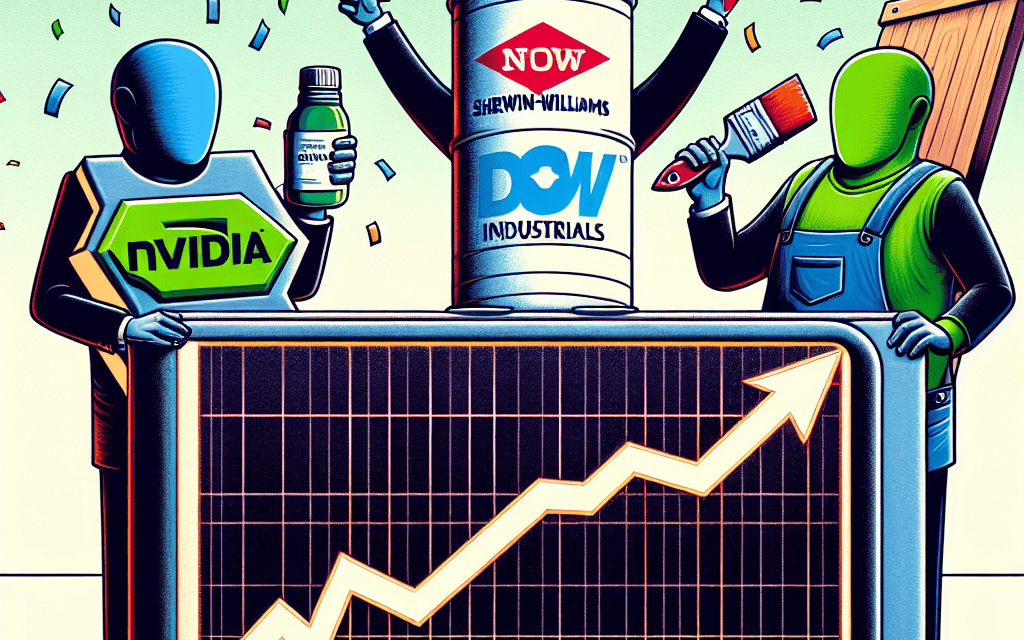“New Horizons: Nvidia and Sherwin-Williams Paint a Future in the Dow Industrials”
Introduction
In a significant reshuffle of the Dow Jones Industrial Average, Nvidia and Sherwin-Williams have been added to the prestigious index, replacing two long-standing members. This move reflects the evolving landscape of the U.S. economy, highlighting the growing importance of technology and consumer goods sectors. Nvidia, a leader in graphics processing units and AI technology, represents the increasing influence of tech innovation on global markets. Meanwhile, Sherwin-Williams, a major player in the paint and coatings industry, underscores the enduring relevance of consumer-focused companies. The inclusion of these two companies marks a strategic update to the Dow, aiming to better represent the current economic environment and growth sectors.
Impact Of Nvidia And Sherwin-Williams Joining The Dow Industrials
The recent inclusion of Nvidia and Sherwin-Williams in the Dow Jones Industrial Average marks a significant shift in the composition of this prestigious stock market index. This change reflects broader trends in the economy and highlights the evolving landscape of American industry. As these two companies join the ranks of the Dow Industrials, they replace long-standing members, signaling a transformation in the sectors that are now considered pivotal to the U.S. economy.
Nvidia, a leader in the technology sector, is renowned for its advancements in graphics processing units (GPUs) and artificial intelligence (AI). Its inclusion in the Dow underscores the growing importance of technology and innovation in driving economic growth. Over the past decade, Nvidia has expanded its influence beyond gaming, venturing into data centers, autonomous vehicles, and AI research. This diversification has positioned Nvidia as a key player in the tech industry, making its addition to the Dow a reflection of the increasing weight of technology companies in the market. The decision to include Nvidia also highlights the shift towards digital transformation, as businesses across various sectors integrate AI and machine learning into their operations.
On the other hand, Sherwin-Williams, a stalwart in the paint and coatings industry, represents the enduring significance of manufacturing and consumer goods. With a history dating back to 1866, Sherwin-Williams has established itself as a leader in its field, known for its innovation in product development and commitment to sustainability. Its inclusion in the Dow is indicative of the continued relevance of traditional industries, even as the economy becomes more technology-driven. The company’s focus on eco-friendly products and sustainable practices aligns with the growing consumer demand for environmentally responsible solutions, further justifying its place in the index.
The companies being replaced in the Dow Industrials are indicative of the changing priorities within the market. As Nvidia and Sherwin-Williams take their places, it is essential to consider the broader implications of these changes. The Dow Jones Industrial Average, often seen as a barometer of the U.S. economy, is designed to reflect the performance of leading companies across various sectors. Therefore, the inclusion of these new members suggests a re-evaluation of what constitutes a leading company in today’s economic climate.
Moreover, the impact of these changes extends beyond the companies themselves. Investors and analysts closely monitor the composition of the Dow, as it influences investment strategies and market perceptions. The addition of Nvidia and Sherwin-Williams may attract new investors seeking exposure to technology and consumer goods, potentially driving up demand for these stocks. Additionally, their presence in the Dow could lead to increased scrutiny and expectations, as they are now part of an index that is closely watched by global markets.
In conclusion, the inclusion of Nvidia and Sherwin-Williams in the Dow Jones Industrial Average is a testament to the dynamic nature of the U.S. economy. It reflects the growing importance of technology and sustainability, while also acknowledging the enduring relevance of traditional industries. As these companies join the ranks of the Dow Industrials, they not only represent their respective sectors but also embody the evolving priorities of the market. This change serves as a reminder of the constant evolution within the economy, as new leaders emerge and redefine what it means to be at the forefront of American industry.
Analysis Of Stocks Replaced By Nvidia And Sherwin-Williams
The recent inclusion of Nvidia and Sherwin-Williams into the Dow Jones Industrial Average marks a significant shift in the composition of this prestigious index, reflecting broader changes in the global economy and stock market dynamics. As these two companies join the ranks of the Dow, it is essential to analyze the stocks they are replacing and understand the implications of these changes for investors and the market as a whole.
Nvidia, a leader in the semiconductor industry, has been at the forefront of technological innovation, particularly in the fields of artificial intelligence and graphics processing. Its addition to the Dow underscores the growing importance of technology companies in driving economic growth and shaping the future of various industries. On the other hand, Sherwin-Williams, a major player in the paint and coatings industry, represents the enduring significance of traditional manufacturing sectors. Its inclusion highlights the continued relevance of companies that produce tangible goods, even as the economy becomes increasingly digital.
The stocks being replaced by Nvidia and Sherwin-Williams are indicative of shifting market trends and investor priorities. Typically, changes in the Dow are made to ensure the index remains a representative snapshot of the broader economy. The companies being removed often reflect sectors or business models that are experiencing slower growth or facing significant challenges. By examining these stocks, we can gain insights into the evolving landscape of the stock market.
One of the stocks being replaced is a company that has faced mounting pressures due to technological disruption and changing consumer preferences. As industries evolve, companies that fail to adapt to new technologies or shifts in consumer behavior may find themselves struggling to maintain their market position. This underscores the importance of innovation and agility in today’s fast-paced business environment. Companies that can successfully navigate these changes are more likely to thrive and secure their place in influential indices like the Dow.
Another stock being replaced may belong to a sector that is experiencing cyclical downturns or structural challenges. For instance, industries heavily reliant on fossil fuels or traditional manufacturing processes may face headwinds due to increasing environmental regulations and the global push towards sustainability. As investors become more conscious of environmental, social, and governance (ESG) factors, companies that do not align with these values may see their attractiveness diminish. This shift in investor sentiment is reflected in the composition of major indices, which increasingly favor companies with strong ESG credentials.
The replacement of these stocks with Nvidia and Sherwin-Williams also highlights the importance of diversification within the Dow. By including companies from different sectors, the index aims to provide a balanced representation of the economy. This diversification helps mitigate risks associated with sector-specific downturns and ensures that the index remains relevant in capturing the overall market performance.
In conclusion, the addition of Nvidia and Sherwin-Williams to the Dow Jones Industrial Average is a testament to the dynamic nature of the stock market and the evolving priorities of investors. By analyzing the stocks being replaced, we gain valuable insights into the challenges faced by certain sectors and the opportunities presented by others. As the economy continues to transform, the composition of major indices like the Dow will undoubtedly continue to evolve, reflecting the ever-changing landscape of global business and finance.
Nvidia’s Journey To The Dow Industrials: Key Milestones
Nvidia’s inclusion in the Dow Jones Industrial Average marks a significant milestone in the company’s journey, reflecting its evolution from a niche graphics processing unit (GPU) manufacturer to a dominant force in the technology sector. This transition is not only a testament to Nvidia’s strategic foresight and innovation but also highlights the shifting landscape of the global economy, where technology companies are increasingly at the forefront.
Founded in 1993, Nvidia initially focused on developing GPUs for the gaming industry. The company’s first major breakthrough came in 1999 with the release of the GeForce 256, which was marketed as the world’s first GPU. This innovation set the stage for Nvidia’s rapid growth, as it capitalized on the burgeoning demand for high-performance graphics in gaming and multimedia applications. Over the years, Nvidia continued to push the boundaries of GPU technology, consistently delivering products that set new standards for performance and efficiency.
As the 21st century progressed, Nvidia recognized the potential of its GPU technology beyond gaming. The company strategically expanded its focus to include data centers, artificial intelligence (AI), and autonomous vehicles. This diversification was a pivotal moment in Nvidia’s journey, as it positioned the company to capitalize on emerging trends in computing and AI. By investing heavily in research and development, Nvidia was able to develop cutting-edge solutions that addressed the needs of these rapidly growing markets.
One of the key milestones in Nvidia’s journey was its foray into AI and machine learning. The company’s GPUs proved to be exceptionally well-suited for the parallel processing tasks required by AI algorithms, making them a popular choice for researchers and developers. Nvidia’s CUDA platform, introduced in 2006, further solidified its position in the AI space by providing a robust framework for developing GPU-accelerated applications. This strategic move not only expanded Nvidia’s market reach but also established it as a leader in AI technology.
In addition to its technological advancements, Nvidia’s strategic partnerships and acquisitions have played a crucial role in its ascent. The acquisition of Mellanox Technologies in 2020, for instance, bolstered Nvidia’s capabilities in high-performance computing and networking, further enhancing its competitive edge. Such strategic moves have enabled Nvidia to build a comprehensive ecosystem of products and services that cater to a wide range of industries.
Nvidia’s financial performance has mirrored its technological achievements, with the company consistently delivering strong revenue growth and profitability. This financial success has been driven by its ability to capture market share in key growth areas, such as data centers and AI, while maintaining its leadership position in gaming. As a result, Nvidia’s market capitalization has soared, making it one of the most valuable technology companies in the world.
The decision to include Nvidia in the Dow Jones Industrial Average underscores the company’s significance in the modern economy. It reflects the growing importance of technology companies in driving economic growth and innovation. As Nvidia joins the ranks of the Dow Industrials, it replaces companies that have been mainstays of the index, highlighting the dynamic nature of the market and the continuous evolution of industry leaders.
In conclusion, Nvidia’s journey to the Dow Industrials is a story of innovation, strategic foresight, and adaptability. From its humble beginnings as a GPU manufacturer to its current status as a technology powerhouse, Nvidia has consistently demonstrated its ability to anticipate and capitalize on emerging trends. As it continues to shape the future of computing and AI, Nvidia’s inclusion in the Dow Jones Industrial Average serves as a fitting recognition of its achievements and its pivotal role in the global economy.
Sherwin-Williams’ Strategic Moves Leading To Dow Inclusion

Sherwin-Williams’ recent inclusion in the Dow Jones Industrial Average marks a significant milestone for the company, reflecting its strategic maneuvers and robust market performance. This development comes alongside Nvidia’s addition to the index, with both companies replacing outgoing stocks. Sherwin-Williams, a global leader in the paint and coatings industry, has demonstrated a consistent ability to adapt and thrive in a competitive market, which has undoubtedly contributed to its recognition and inclusion in this prestigious index.
The decision to include Sherwin-Williams in the Dow Industrials is not arbitrary; it is a testament to the company’s strategic initiatives and financial health. Over the years, Sherwin-Williams has focused on expanding its market presence through both organic growth and strategic acquisitions. By acquiring companies that complement its existing portfolio, Sherwin-Williams has been able to enhance its product offerings and expand its reach into new markets. This strategy has not only increased its market share but also solidified its position as a leader in the industry.
Moreover, Sherwin-Williams has consistently invested in research and development to innovate and improve its product lines. This commitment to innovation has allowed the company to meet evolving consumer demands and environmental standards, thereby maintaining its competitive edge. By prioritizing sustainability and eco-friendly products, Sherwin-Williams has aligned itself with global trends, appealing to a broader customer base and reinforcing its brand reputation.
In addition to its strategic acquisitions and product innovation, Sherwin-Williams has also focused on operational efficiency. By streamlining its supply chain and optimizing its manufacturing processes, the company has been able to reduce costs and improve profitability. This focus on efficiency has been crucial in maintaining its financial stability and delivering value to shareholders, further justifying its inclusion in the Dow Industrials.
The inclusion of Sherwin-Williams in the Dow Jones Industrial Average also reflects broader market trends and the evolving composition of the index. As the economy shifts and new industries emerge, the Dow must adapt to remain representative of the current market landscape. The addition of Sherwin-Williams, alongside Nvidia, highlights the growing importance of technology and consumer goods sectors in the modern economy. This shift underscores the need for the index to evolve and incorporate companies that are driving innovation and growth.
While Sherwin-Williams’ inclusion in the Dow is a significant achievement, it also places the company under increased scrutiny. As part of the index, Sherwin-Williams will be closely watched by investors and analysts, who will expect continued strong performance and strategic foresight. This heightened attention will require the company to maintain its focus on innovation, efficiency, and market expansion to meet the expectations of its stakeholders.
In conclusion, Sherwin-Williams’ strategic moves, including acquisitions, product innovation, and operational efficiency, have played a pivotal role in its inclusion in the Dow Jones Industrial Average. This achievement not only reflects the company’s past successes but also sets the stage for its future growth and development. As Sherwin-Williams continues to navigate the challenges and opportunities of the global market, its inclusion in the Dow serves as both a recognition of its accomplishments and a mandate for continued excellence.
Market Reactions To Nvidia And Sherwin-Williams’ Dow Entry
The recent inclusion of Nvidia and Sherwin-Williams into the Dow Jones Industrial Average marks a significant shift in the composition of this prestigious index, reflecting broader changes in the global economy and market dynamics. As these two companies join the ranks of the Dow, they replace ExxonMobil and Pfizer, signaling a move towards sectors that are increasingly influential in today’s economic landscape. This transition has sparked varied reactions from market analysts and investors, who are keenly observing the implications of these changes on the index’s performance and the broader market.
Nvidia, a leader in the semiconductor industry, has been at the forefront of technological innovation, particularly in areas such as artificial intelligence, gaming, and data centers. Its inclusion in the Dow is a testament to the growing importance of technology companies in driving economic growth and shaping the future. The company’s robust financial performance and strategic positioning in high-growth markets have made it an attractive addition to the index. Investors are optimistic that Nvidia’s presence in the Dow will bring a fresh perspective and enhance the index’s representation of the technology sector, which has been a key driver of market performance in recent years.
On the other hand, Sherwin-Williams, a global leader in the paint and coatings industry, represents a more traditional sector that continues to play a vital role in the economy. The company’s strong brand, extensive distribution network, and consistent financial performance have earned it a place in the Dow. Sherwin-Williams’ inclusion highlights the enduring significance of industrial and consumer goods companies, even as the market increasingly focuses on technology and innovation. This move is seen as a balancing act, ensuring that the Dow maintains a diverse representation of industries that contribute to economic stability and growth.
The replacement of ExxonMobil and Pfizer, two long-standing members of the Dow, has not gone unnoticed. ExxonMobil’s removal reflects the challenges faced by the energy sector, particularly in the context of the global shift towards renewable energy and sustainability. The company’s declining market capitalization and the growing emphasis on environmental, social, and governance (ESG) factors have contributed to its exclusion from the index. Similarly, Pfizer’s removal comes at a time when the pharmaceutical industry is undergoing significant transformation, with increased competition and regulatory scrutiny impacting its market position.
Market reactions to these changes have been mixed. Some investors view the inclusion of Nvidia and Sherwin-Williams as a positive development, bringing new growth opportunities and diversification to the Dow. Others, however, express concerns about the potential volatility associated with technology stocks and the implications of removing established companies like ExxonMobil and Pfizer. As the market adjusts to these changes, analysts are closely monitoring the performance of the Dow and its new constituents, assessing how these shifts will influence investor sentiment and market trends.
In conclusion, the entry of Nvidia and Sherwin-Williams into the Dow Jones Industrial Average marks a pivotal moment in the index’s history, reflecting broader economic trends and the evolving landscape of global markets. While the replacement of ExxonMobil and Pfizer underscores the challenges faced by traditional industries, it also highlights the opportunities presented by emerging sectors. As investors navigate these changes, the focus will remain on how these shifts impact the Dow’s performance and its ability to represent the diverse and dynamic nature of the modern economy.
Future Prospects For Nvidia And Sherwin-Williams In The Dow
The inclusion of Nvidia and Sherwin-Williams in the Dow Jones Industrial Average marks a significant shift in the composition of this prestigious index, reflecting broader changes in the global economy and the stock market. As these two companies replace outgoing stocks, their future prospects within the Dow are of considerable interest to investors and analysts alike. Nvidia, a leader in the semiconductor industry, and Sherwin-Williams, a dominant player in the paint and coatings sector, bring unique strengths and opportunities to the index.
Nvidia’s entry into the Dow is emblematic of the growing importance of technology in the modern economy. As a company renowned for its graphics processing units (GPUs) and artificial intelligence (AI) capabilities, Nvidia is well-positioned to capitalize on the increasing demand for advanced computing solutions. The rise of AI, machine learning, and data analytics has created a fertile ground for Nvidia’s products, which are integral to these technologies. Moreover, the company’s strategic investments in autonomous vehicles and data centers further enhance its growth potential. As industries across the board continue to digitize and automate, Nvidia’s role in providing the necessary hardware and software solutions is likely to expand, making it a valuable addition to the Dow.
On the other hand, Sherwin-Williams represents a more traditional sector, yet its inclusion underscores the enduring relevance of manufacturing and consumer goods. As a leading manufacturer of paints and coatings, Sherwin-Williams has a robust market presence and a strong brand reputation. The company’s extensive distribution network and commitment to innovation in product development have allowed it to maintain a competitive edge. Furthermore, as the global economy recovers from recent disruptions, the construction and home improvement sectors are expected to experience growth, providing a favorable environment for Sherwin-Williams. The company’s focus on sustainability and eco-friendly products also aligns with the increasing consumer demand for environmentally responsible options, positioning it well for future success.
The replacement of stocks in the Dow is not merely a reflection of past performance but also an indication of future potential. Nvidia and Sherwin-Williams bring diverse strengths to the index, offering a blend of technological innovation and manufacturing prowess. This combination is likely to provide stability and growth, benefiting the overall performance of the Dow. As these companies integrate into the index, their ability to adapt to changing market conditions and leverage their respective strengths will be crucial.
In conclusion, the addition of Nvidia and Sherwin-Williams to the Dow Jones Industrial Average highlights the evolving landscape of the stock market and the economy at large. Nvidia’s technological expertise and Sherwin-Williams’ manufacturing capabilities offer promising prospects for the future. As these companies navigate the challenges and opportunities ahead, their performance will be closely watched by investors and analysts. The dynamic nature of the Dow ensures that it remains a relevant and accurate reflection of the economic zeitgeist, and the inclusion of Nvidia and Sherwin-Williams is a testament to their potential to contribute to this legacy. As they embark on this new chapter, their journey will undoubtedly be one of interest and significance in the world of finance.
Historical Context: Changes In The Dow Industrials Over The Years
The Dow Jones Industrial Average (DJIA), often referred to simply as the Dow, has long been a barometer of the American economy, reflecting the performance of 30 prominent companies across various industries. Over the years, the composition of the Dow has evolved, mirroring shifts in the economic landscape and the rise of new industries. The recent inclusion of Nvidia and Sherwin-Williams in the Dow Industrials marks another significant change, as these companies replace others that have been part of this prestigious index. This transition underscores the dynamic nature of the Dow and its ability to adapt to the changing economic environment.
Historically, the Dow has undergone numerous changes since its inception in 1896, when it was first introduced by Charles Dow and Edward Jones. Initially comprising 12 companies, the index has expanded and contracted over time, reflecting the ebb and flow of the American economy. The original list included companies from industries such as railroads, cotton, gas, sugar, tobacco, and oil, which were dominant at the time. As the economy evolved, so too did the composition of the Dow, with companies from emerging sectors such as technology, healthcare, and consumer goods gradually making their way into the index.
The inclusion of Nvidia, a leader in graphics processing units and artificial intelligence, highlights the growing importance of technology in today’s economy. Nvidia’s rise to prominence is emblematic of the broader shift towards digitalization and the increasing reliance on technology across various sectors. This change is not merely a reflection of Nvidia’s success but also an acknowledgment of the critical role that technology plays in driving economic growth and innovation. As the world becomes more interconnected and reliant on digital solutions, the presence of technology companies in the Dow is likely to continue expanding.
Similarly, the addition of Sherwin-Williams, a global leader in the paint and coatings industry, underscores the enduring significance of manufacturing and consumer goods. Sherwin-Williams’ inclusion in the Dow is a testament to its resilience and adaptability in a competitive market. The company’s ability to innovate and meet the evolving needs of consumers has solidified its position as a key player in the industry. This move also reflects the ongoing importance of traditional industries, even as new sectors emerge and gain prominence.
The companies being replaced in the Dow are often those that have struggled to adapt to changing market conditions or have seen their influence wane over time. This process of replacement is not uncommon and serves as a reminder of the need for companies to remain agile and forward-thinking. The Dow’s ability to incorporate new companies while phasing out others ensures that it remains a relevant and accurate reflection of the broader economy.
In conclusion, the inclusion of Nvidia and Sherwin-Williams in the Dow Industrials is a significant development that highlights the evolving nature of the American economy. As the Dow continues to adapt to changes in the economic landscape, it remains a vital tool for investors and analysts seeking to understand market trends and the performance of leading companies. This latest change serves as a reminder of the importance of innovation and adaptability in maintaining a competitive edge in an ever-changing world.
Q&A
1. **Question:** What companies were added to the Dow Jones Industrial Average in the recent update?
– **Answer:** Nvidia and Sherwin-Williams were added to the Dow Jones Industrial Average.
2. **Question:** Which companies were removed from the Dow Jones Industrial Average to make room for Nvidia and Sherwin-Williams?
– **Answer:** The companies that were removed were Honeywell International and United Technologies.
3. **Question:** Why was Nvidia chosen to be added to the Dow Jones Industrial Average?
– **Answer:** Nvidia was chosen due to its significant growth and influence in the technology sector, particularly in graphics processing and AI.
4. **Question:** What is the significance of Sherwin-Williams being added to the Dow Jones Industrial Average?
– **Answer:** Sherwin-Williams’ addition reflects the importance of the consumer goods sector and the company’s strong market position in paints and coatings.
5. **Question:** How often does the Dow Jones Industrial Average undergo changes in its composition?
– **Answer:** The Dow Jones Industrial Average does not have a fixed schedule for changes; adjustments are made as needed to reflect the evolving economy.
6. **Question:** What impact do changes in the Dow Jones Industrial Average have on the stock market?
– **Answer:** Changes can influence investor perception and trading activity, as inclusion in the Dow is seen as a mark of prestige and stability.
7. **Question:** How does the inclusion of Nvidia and Sherwin-Williams affect the diversity of the Dow Jones Industrial Average?
– **Answer:** Their inclusion increases the diversity by adding more representation from the technology and consumer goods sectors.
Conclusion
The inclusion of Nvidia and Sherwin-Williams in the Dow Jones Industrial Average marks a significant shift in the index, reflecting the evolving landscape of the U.S. economy. Nvidia, a leader in the semiconductor industry, represents the growing importance of technology and innovation, particularly in areas like artificial intelligence and data processing. Sherwin-Williams, a major player in the paint and coatings industry, underscores the enduring relevance of manufacturing and consumer goods. The stocks being replaced may indicate a move away from sectors that are less aligned with current economic trends. Overall, this change highlights the Dow’s ongoing adaptation to better represent the dynamic nature of the market and the economy.





